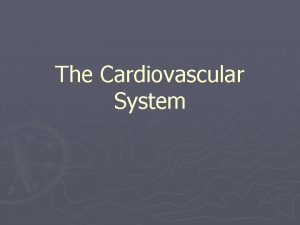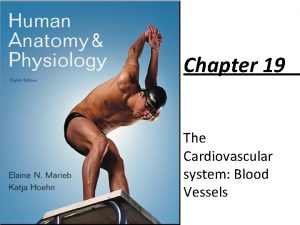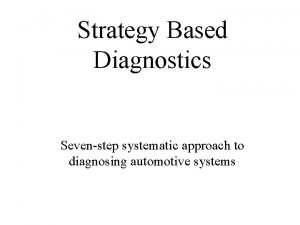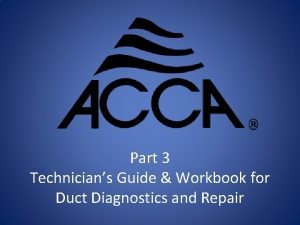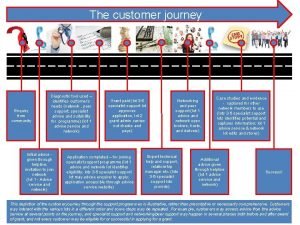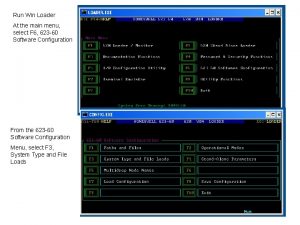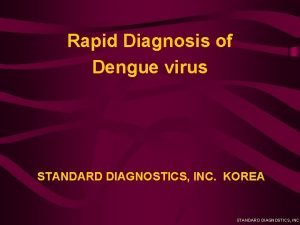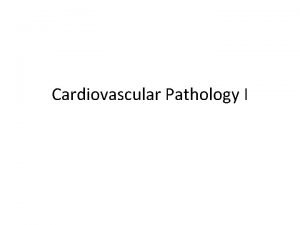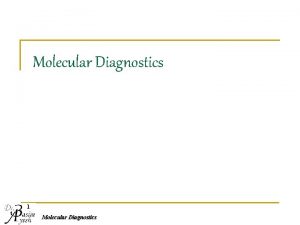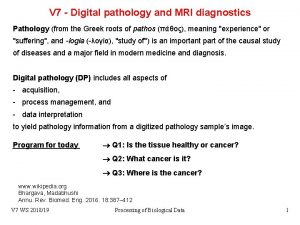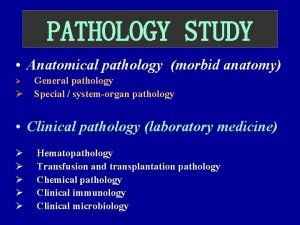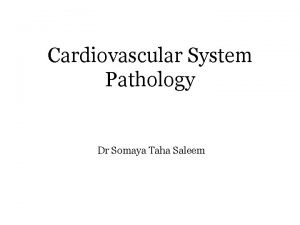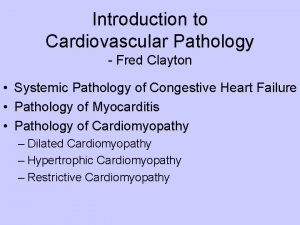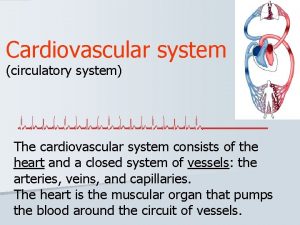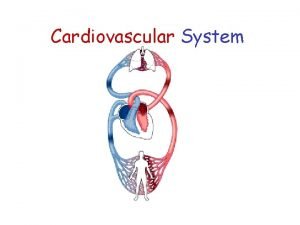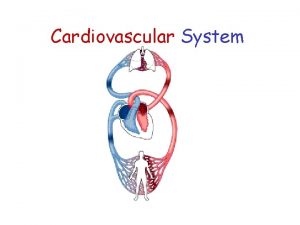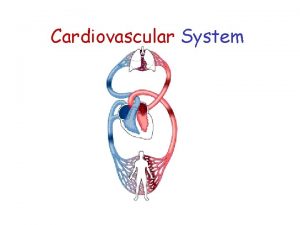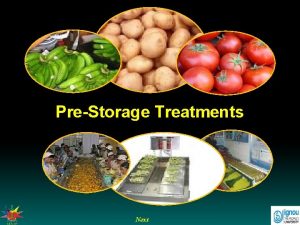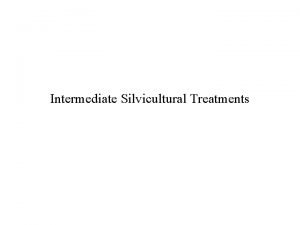Cardiovascular System Ch 5 Diagnostics Pathology Treatments Cardiovascular



























- Slides: 27

Cardiovascular System (Ch 5) Diagnostics, Pathology, & Treatments

Cardiovascular Specialists • Cardiologist • Hematologist-specialist who treats diseases and disorders of the blood

DIAGNOSTIC PROCEDURES

Diagnostic procedures • Angiography – radiographic study of the blood vessels after the injection of a contrast medium • Angiocardiography – uses a contrast medium and chest x-rays to visualize the dimensions of the heart and large blood vessels

Diagnostic Procedures • History & Physical – Checking for symptoms of disease • Chest pain, shortness of breath, awareness of heartbeat (palpitation), fatigue, dizziness or loss of consciousness, edema, pain in the legs while walking (claudication)

Diagnostic Procedures • Cardiac catheterization – a procedure in which a catheter is passed into a vein or artery and is guided into the heart – X-rays taken during the procedure – Dye is also injected

Diagnostic procedures • Electrocardiography-tracing electricity – Electrocardiogram – ECG – EKG – Holter monitor – portable EKG that is worn by an ambulatory patient to continuously monitor the heart rates and rhythms over a 24 -hour period. – Stress tests – Thallium stress test – uses a radiopharmaceutical to test heart function

Diagnostic procedures • Ultrasonic diagnostic procedures • Ultra sound – Echocardiography – the use of sound waves to evaluate the structures and motion of the heart • Pulse ox

PATHOLOGY

Blood Vessel Pathology • Angiitis • Angionecrosis-tissue death of the walls of blood vessels • Angiostenosis – Abnormal narrowing of a blood vessel – Angiospasm – Angina pectoris – severe episodes of spasmodic, choking chest pain

Pathology • Arteries – Aneurysm – a localized weak spot or balloon-like enlargement of the wall of an artery that can rupture – Arteritis – Polyarteritis – Arteriosclerosis-hardening of the arteries – Raynaud’s phenomenon – intermittent attacks of pallor, cyanosis, and redness of the fingers and toes due to arterial contraction.

Pathology • Atherosclerosis – Hardening and narrowing of the arteries due to fatty deposits on the walls of the arteries – Causes • • Increased blood lipids High blood presssure Smoking Obesity Physical inactivity Tension http: //www. nlm. nih. gov/medlineplus/ency/anatomyvid eos/000006. htm

Atherosclerosis can lead to; • Angina pectoris-coronary arteries are temporarily blocked-reduced blood supply to the heart – chest pain • ischemia – oxygen deprived heart muscle, injured muscle • Myocardial Infarction, heart attack– necrosis of the heart muscle due to severe, prolonged ischemia,

Pathology • Coronary artery disease (CAD) • Congestive Heart Failure (CHF) – Pumping action is diminished – Fluid accumulates and is retained in the tissues • Carditis

Congenital Heart Disease • Defects in the heart that occurred during fetal development • Involves defective communication between the chambers, malformation of the valves, and malformation of the septa • Cyanotic – inability of the individual to get adequate oxygen so they turn blue

Pathology • Arrhythmias-abnomality in rate, rhythm, or conduction of the heart beat – Fibrillation-rapid, irregular, ineffective contractions, quivering • Atrial fibrillation-irregular quivering action of the atria. Results in very rapid ventricular heartbeat • V fib – fatal unless reversed – Flutter – Bradycardia-abnormally slow heartbeat – Tachycardia

• Veins Pathology – Phlebitis – inflammation of a vein – Varicose veins-enlarged veins which can be inflammed • Hemorrhoids – varicose veins of the rectal & anal area – Valvulitis-inflammation of a heart valve – Phlebostenosis – narrowing of the lumen of a vein from any cause • Thrombus-blood clot circulating in the blood stream • Thrombosis-abnormal condition of clot formation • Embolisms – any foreign object circulating in the blood stream; clot, air, fat particle, plastic from IV catheters, etc. • Blood disorders – Dyscrasia – any abnormal or pathologic condition of the blood – Hemochromatosis – Septicemia – also known as blood poisoning, is the presence of pathogenic microorganisms or their toxins in the blood.

Pathology • Blood cells – Erythrocytosis – abnormal increase in the number of circulating red blood cells – Thrombocytopenia – also known as thrombopenia, is an abnormal decrease in the number of platelets – Leukopenia – an abnormal decrease in the number of white blood cells. May affect one or all types. – Leukemia

Pathology • Anemias – a disorder characterized by lower than normal levels of red blood cells in the blood – Aplastic – an absence of all formed blood elements – Hemolytic – red blood cells are destroyed faster than the bone marrow can replace them – Iron deficient – Megaloblastic – large abnormal red blood cells (megaloblasts) with a reduced capacity to carry oxygen are produced by the bone marrow

Pathology • Anemias continued – Sickle cell – Pernicious – Thalassemia – Cooley’s anemia, group of genetic disorders characterized by short-lived red blood cells that lack the normal ability to produce hemoglobin

Pathology • Hypertension (HTN) – Essential – primary – idiopathic – consistently elevated blood pressure of unknown origin 90% of cases – Secondary – caused by a different medical problem such as a kidney disorder or a tumor on the adrenal glands 10% of cases – Malignant – characterized by the sudden onset of severely elevated blood pressure

TREATMENTS

Treatments • Antihypertensive medications – ACE inhibitors – Beta-blockers – Calcium channel blockers – Diuretics

Treatments • Additional medications – Statins – Digoxin – Nitroglycerin – Anticoagulant – thrombolytic – Antiarrhythmic-controls irregularities of the heartbeat – Tissue plasminogen activator (TPA)-used to dissolve clots

Treatments • Coronary artery bypass graft – CABG – bypass surgery • Heart – Defibrillation – Cardioversion – Pacemaker – CPR

Treatments • Clearing blocked arteries – Percutaneous transluminal coronary angioplasty – PTCA – balloon angioplasty, opens the blocked artery but doesn’t actually remove the plaque – http: //www. nlm. nih. gov/medlineplus/ency/a natomyvideos/000096. htm – Atherectomy – surgical removal of plaque from the interior lining of an artery

Treatments – Endarterectomy – surgical removal of the lining of an artery that is clogged with plaque – Carotid endarterectomy – same as above for a carotid artery
 Mitel presenter
Mitel presenter The circulatory or cardiovascular system chapter 19
The circulatory or cardiovascular system chapter 19 What makes up the cardiovascular system
What makes up the cardiovascular system Pithed rat model
Pithed rat model Cardiovascular/lymphatic system it's totally tubular
Cardiovascular/lymphatic system it's totally tubular Circulatory system crash course
Circulatory system crash course Chapter 5 the cardiovascular system labeling exercises
Chapter 5 the cardiovascular system labeling exercises Figure 11-9 is a diagram of the hepatic portal circulation
Figure 11-9 is a diagram of the hepatic portal circulation Figure 11-2 is an anterior view of the heart
Figure 11-2 is an anterior view of the heart Lesson 11 cardiovascular system
Lesson 11 cardiovascular system Lesson 11 cardiovascular system
Lesson 11 cardiovascular system Tissues in circulatory system
Tissues in circulatory system Chapter 11 the cardiovascular system
Chapter 11 the cardiovascular system Introduction of heart
Introduction of heart Stent placement
Stent placement Anatomy and physiology unit 7 cardiovascular system
Anatomy and physiology unit 7 cardiovascular system Chapter 8 cardiovascular system
Chapter 8 cardiovascular system Chapter 13 cardiovascular system
Chapter 13 cardiovascular system Chapter 11 the cardiovascular system figure 11-2
Chapter 11 the cardiovascular system figure 11-2 The cardiovascular system includes the
The cardiovascular system includes the Major arteries
Major arteries Chapter 19 the cardiovascular system blood vessels
Chapter 19 the cardiovascular system blood vessels Gm strategy based diagnostics chart
Gm strategy based diagnostics chart Duct
Duct Customer journey diagnostics
Customer journey diagnostics Winloader
Winloader Standard diagnostics inc
Standard diagnostics inc Erd commander 2010
Erd commander 2010



















